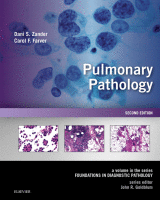Physical Address
304 North Cardinal St.
Dorchester Center, MA 02124

Introduction Non–small cell lung cancer (NSCLC) is the second most common cancer diagnosed in the United States and the leading cause of cancer-related mortality, with an estimated 221,200 new cases and 158,040 deaths anticipated in 2015. Lung cancer was the…

Introduction This chapter addresses a variety of lung lesions that represent repair reactions, inclusions, deposition disorders, and masses of uncertain etiology. They may present as single or multiple lesions or as infiltrative lesions. They may be secondary to systemic diseases,…

Complications of Lung Transplantation Lung transplantation, whether single, bilateral, or, less often, heart–lung, has been an accepted mode of therapy for a variety of end-stage lung diseases for about 25 years. The most common indications for transplantation in adults are…

Introduction The mononuclear phagocyte system includes monocytes, macrophages/histiocytes, and dendritic cells. Macrophages/histiocytes are tissue-based cells that have an important phagocytic function and produce a variety of bioactive substances that play roles in inflammation and fibrosis. Alveolar macrophages are a normal…

Introduction Pulmonary lymphoproliferative disorders encompass a spectrum of benign and malignant lymphoid proliferations. Benign proliferations include intraparenchymal lymph nodes, follicular bronchiolitis, lymphoid interstitial pneumonia (LIP) (sometimes encompassed under the term diffuse lymphoid hyperplasia ), localized pulmonary “nodular” lymphoid hyperplasia, and…

Introduction Bronchiolitis is a general term used to describe inflammatory lung diseases primarily affecting the small conducting airways and often (but not always) sparing the more distal lung parenchyma. It may occur in isolation, but sometimes it may be a…

Introduction The disorders included in this chapter are grouped under the heading “obstructive lung diseases.” These diseases share the characteristic of increased resistance to airflow, which can be caused by either an increase in the resistance of the conducting airways…

Introduction Drug-induced lung injury is common and can be induced by a wide variety of drugs used for treatment of many different clinical conditions. More than 600 prescribed medications have been reported to cause drug-induced pulmonary toxicity. Adverse drug reactions…

Introduction Exposures to environmental agents can result in a wide spectrum of pulmonary pathologic patterns ( Table 18.1 ). The most common reactions are chronic due to exposure to mineral(s) over a cumulative period and have latencies often exceeding several…

Hypersensitivity Pneumonitis Hypersensitivity Pneumonitis—Fact Sheet Definition ▪ Diffuse interstitial granulomatous pneumonitis, caused by exposure to inhaled organic antigens or other particles of small size in susceptible individuals ▪ Large number of syndromes associated with specific triggering agents; major categories of…